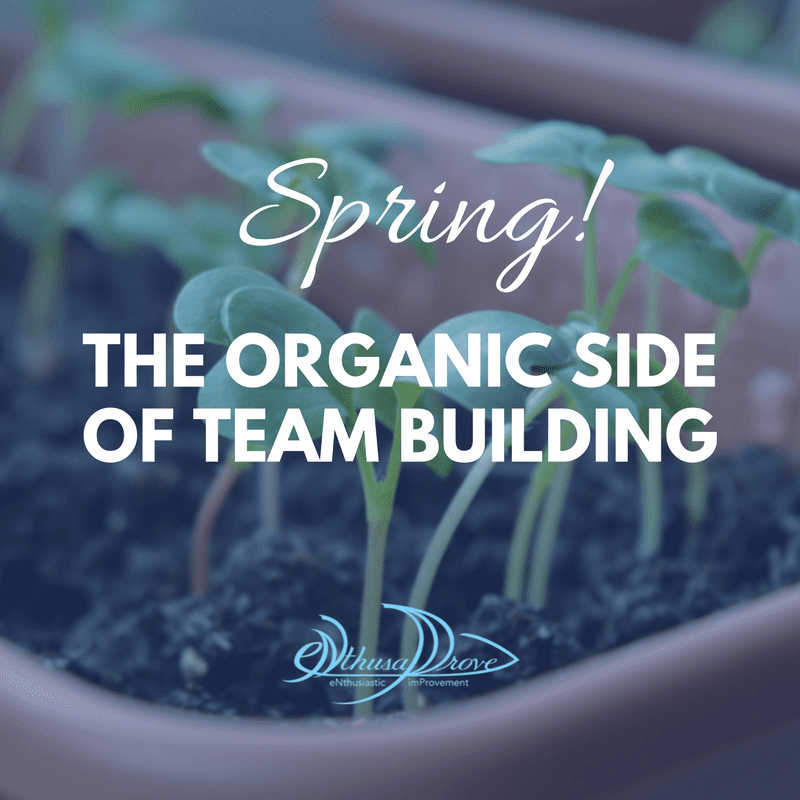 Have you seen spring yet? Here in central Pennsylvania we are seeing a very slow appearance of spring, with cold temperatures and April snow. May is bringing a glimmer of hope that spring is coming!
Have you seen spring yet? Here in central Pennsylvania we are seeing a very slow appearance of spring, with cold temperatures and April snow. May is bringing a glimmer of hope that spring is coming!
This time of year brings to my mind that teams trying to bring new ideas to fruition have a lot in common with the little seedlings that we started in our greenhouse months ago. We start with something that looks hard, lifeless, and seemingly too small to do anything. To bring life to this seed, we:
- provide a warm (welcoming) environment.
- provide water…not a lot; a little at a time, consistently and gently.
- nurture them. We don’t immediately send them to the outdoors.
- notice when their little pot is constraining…so we add nutrients, maybe even transplant them to a bigger pot.
- give them sunshine while carefully making sure they don’t get dried out or wilted. Too much of a good thing is detrimental to this young life.
Do you see similarities with how your team grooms new ideas?
Starting Idea Seedlings
These fledgling ideas (and plants) need a serving leader. The team has hard work in front of them, so in those initial stages we don’t start with how big the problem is, or how hard it will be, or how it failed before. That would be like starting seeds in a drought box located in the basement, depriving the seeds of the light and warmth that they need to grow. (For those who are plant challenged, that would mean the seeds won’t sprout into plants.)
How do you nurture an idea?
With a seedling, when they first pop up, we are gentle and protective of them. Putting a seedling out in the elements ensures withering. It is the same with ideas. When an idea first germinates, we need to be gentle with it. Many teams we work with try to put initial ideas through testing way too early, only to see it whither on the vine. It’s easy to take a new idea and just pull it out, to ignore it, or mistake them for a weed. We need to give those ideas space to become something bigger, better.
Application Point: When working with a new idea, find ways to build upon the idea (vice critique). How can you critique something that you can’t barely tell if it will be a weed or a beautiful flower? Be the gentle watering. For example, try adding to the idea, finding connections to other things, or connecting the idea to a customer need.
Strength Building for Ideas
As plants are growing stronger, we are planning… just how to arrange them in their rows or beds, to pair them with beneficial plants, testing the soil, doing risk mitigation for the pests they will face. Then, we explore integrating it with established processes, feasibility, and usefulness to the customer. This is building the strength for the plant, and building confidence with the idea that it is workable and valuable.
Application Point: The team leader needs to be:
- scouting the horizon of the organization to see where our team’s ideas, solutions and recommendations can best take hold.
- looking for areas where maybe we can piggyback with other initiatives.
- seeking out ways to beta test the ideas…like repotting a seedling to see it further grow.
Know the Plants You’ve Got
As you strengthen your garden, it’s beneficial to recognize that we never expect the tomato plant to be anything but a tomato, and the marigold to be anything but a marigold. The tomato plant’s job is to produce fruit, not a bush, and the marigold is to produce a flower and keep out the critters.
Ok, but what is the Team Leader correlation? We have put up a few blogs about working with strengths, and the greenhouse provides ample validation of that. Just like we only rely on the strengths of each plant, we build on each member’s strengths. If our team needs something not found on the team, it’s best to bring in that talent. Ok, I understand we don’t live in a world of unlimited resources. So, when we do have to have team members fill in on areas not their strength, we as Team Leaders need to up our game as serving leaders. Yelling at the tomatoes for letting in the critters won’t help.
Building good soil vice quick fixes
On my little niche farm in Lancaster, we make a promise to not use any non-organic measures in the lifecycle of our plants or soil. That makes it hard, and it pretty much eliminates any quick fix remedies. Mother Nature is kind, bounteous and, in her time, forgiving.
For me, this is the most powerful reminder. Team dynamics are a natural process that are best handled organically, not mechanically. Like nature’s flora, teams can be bounteous, but we can fake ourselves out with quick fixes like extrinsic rewards or using fear tactics (like the ever common ‘burning platform’ metaphor). But as Team Leaders, especially those of us with standing or long-term teams, we need to have patience and work with teams to build good soil in which the people and ideas will grow.
Application Point: Are you employing fear or extrinsic rewards to build your team? Beware. These often backfire in the long run. Just ask Herzberg.
So what?
Some of the best answers to team dynamics issues come from the world around us. This idea of idea seedlings growing up into hearty value offerings is a cool connection that we are excited to think about. It could be because winter is finally breaking and letting spring come through!
It’s time for the growing season, for seedlings and for your team’s ideas!
P.S. Last week’s blog about Millennials had a lot of people sharing stories with us. We are working on diving into this topic further in weeks to come. Did you miss it? Check it out here.






